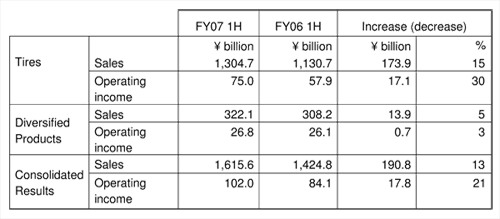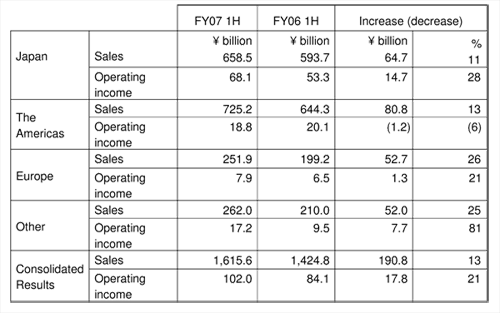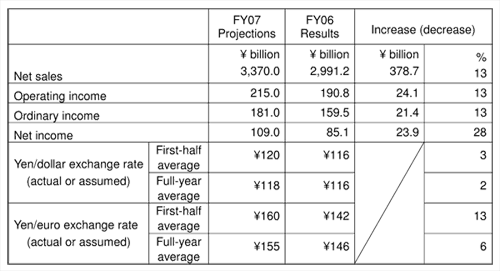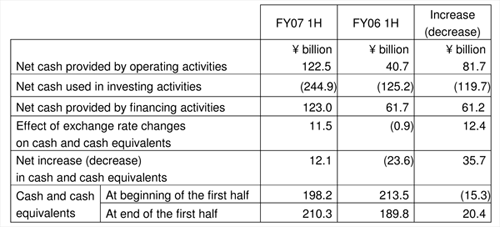Bridgestone Corporation Announces Business and Financial Results for First Half of Fiscal 2007
Tokyo (August 9, 2007) –Bridgestone Corporation (the “Company”) today announced its consolidated business and financial results for the period January 1 to June 30, 2007, the first half of the current fiscal year (January 1 to December 31, 2007). These results are for the Company and its consolidated subsidiaries, collectively referred to below as the “Companies.” The Company had 454 consolidated subsidiaries and 180 equity method affiliates at June 30, 2007.
Here is a summary of the Companies’ first half results in 2007 and management’s projections for the Companies’ sales and earnings performance for the full year of fiscal year 2007. Solely for the convenience of readers, the dollar figures have been calculated at US$1 = ¥123.26, the exchange rate on June 30.
I. Summary of Business and Financial Performance
A. Sales and earnings
1. Overall Results

A defining trend of the business environment in the first half was continued global upward movement in the cost of crude oil and other raw materials. The Japanese economy continued to recover gradually as a result of improving corporate earnings and increases in capital spending. In the United States, the economy showed solid expansion in the second quarter after a first quarter that showed little growth. This economic performance was based on continued strength in consumer spending, despite a significant slowdown in housing construction and residential mortgage activity. Economic recovery continued in Europe, supported by strong exports and increasing capital investment. Strong economic growth continued in China while other Asian economies expanded steadily.
Amid such a business environment, the Companies continued efforts to increase production capacity in strategic product lines and continued to benefit from their strengths in research and development. Those efforts enabled the Companies to provide products worldwide in a timely manner that fulfill the quality and performance requirements of customers. Additionally, the Companies also continued group-wide efforts to enhance their portfolio of highly competitive products and businesses despite an increasingly difficult business environment caused by changes in the structure of demand and competition.
As a result, net sales in the first half increased 13% over the previous first half, to ¥1,615.6 billion [$13.1 billion] due in part to the exchange gain on the weaker Japanese yen, while operating income increased 21%, to ¥102.0 billion [$828 million] and ordinary income increased 29%, to ¥91.3 billion [$741 million] as the Companies worked to mitigate the impact of increasing raw material costs. Net income grew 61%, to ¥52.9 billion [$429 million].
The Companies accrued pretax ¥15.8 billion [$128 million] as an extraordinary loss during the first half of the previous fiscal year in connection with the announced closure of two tire plants in the Americas.
2. Segment Information
Note: The amounts for segment results include inter-segment transactions that are eliminated in calculating the consolidated results.
a. By business segment

In the tire segment, the Companies’ operating income in the first half increased 30% over the previous first half, to ¥75.0 billion [$608 million], on an increase of 15% in sales, to ¥1,304.7 billion [$10.6 billion]. The Companies worked to maximize their sales momentum by introducing appealing new products worldwide, while at the same time, improving and expanding strategic production sites around the world in support of those products that have been identified as strategic and important to the Companies’ future growth.
In the diversified products segment, the Companies’ operating income in the first half increased 3% over the previous first half, to ¥26.8 billion [$217 million], on an increase of 5% in sales, to ¥322.1 billion [$2.6 billion] due in part to strong sales in the automotive components and the commercial building materials operations in the United States.
b. By geographical segment

Sales in Japan increased 11%, to ¥658.5 billion [$5.3 billion] over the previous first half, and operating income increased 28%, to ¥68.1 billion [$552 million], despite increasing raw material costs. Unit sales of tires in the domestic market remained on a par with those in the previous first half, while unit exports substantially exceeded those in the previous first half. On the whole, sales in the diversified products business also grew steadily.
In the Americas, the Companies’ sales in the first half increased 13%, to ¥725.2 billion [$5.9 billion], due in part to the exchange gain on the weaker Japanese yen, while operating income decreased 6%, to ¥18.8 billion [$153 million], due in part to high raw material costs and an increase of costs associated with expanding operations. Although unit sales of passenger car and light truck tires remained unchanged from the previous first half and unit sales of truck and bus tires declined over the previous first half due mostly to a decrease of OEMs sales, dollar sales exceeded the previous first half’s results. In addition to expanding sales of high-value-added products, almost all operations including the retail and commercial sales operations in North America, the Latin American tire operations and the diversified products businesses showed solid growth.
Sales in Europe increased 26%, to ¥251.9 billion [$2.0 billion] due in part to the exchange gain on the weaker Japanese yen. Operating income was up 21%, to ¥7.9 billion [$64 million], despite increasing raw material costs. Unit sales of passenger car and light truck tires grew steadily, while unit sales of truck and bus tires increased significantly over the previous first half.
In other regions, sales grew 25% to ¥262.0 billion [$2.1 billion], spurred by vigorous marketing activities, efforts to improve and expand production sites in strategic areas and for strategic products, and the exchange gain on the weaker Japanese yen. Operating income increased 81%, to ¥17.2 billion [$140 million], despite increasing raw material costs.
B. Projections
In Japan, management expects unit sales of tires for the domestic market in 2007 to remain on par with the prior year. They also project unit exports of tires to exceed those in 2006.
In the Americas, management projects unit sales of passenger car and light truck tires to remain on par with the prior year. They also project a decline in unit sales of OE truck and bus tires versus the prior year due to the extraordinary demand in 2006 for new truck and bus tires spurred by “pre-buy” activities in advance of new environmental regulations which took effect in January of this year.
In Europe, management expects unit sales gains in passenger car, light truck, truck and bus tires over the prior year.
The operating environment is expected to remain challenging despite burgeoning tire demand, particularly overseas. Profitability is still an issue, however, as the cost of raw materials used in the Companies’ products remains high.
The following table presents a summary of management’s business projections for 2007.

II. Financial Position
1. Cash Flow

The Companies’ cash and cash equivalents increased ¥12.1 billion [$98 million] during the first half of 2007, to ¥210.3 billion [$1,706 million], compared with a decrease of ¥23.6 billion [$191 million] during the prior year first half.
(Cash flow by operating activities)
Net cash provided by operating activities increased ¥81.7 billion [$663 million] compared with the prior year first half, to ¥122.5 billion [$994 million]. The principal contributors to that increase included income before income taxes and minority interests of ¥91.3 billion [$741 million], compared with ¥60.1 billion [$488 million] in the prior year first half; and depreciation and amortization of ¥79.8 billion [$647 million], compared with ¥70.1 billion [$569 million] in the prior year first half. Those contributors offset a decrease in accrued pension and liability for retirement benefits of ¥11.1 billion [$90 million], compared with a decrease of ¥5.0 billion [$41 million] in the prior year first half; and ¥31.9 billion [$259 million] in income taxes paid, compared with ¥32.6 billion [$264 million] in the prior year first half.
(Cash flow by investing activities)
Net cash used in investing activities increased ¥119.7 billion [$971 million] compared with the prior year first half, to ¥244.9 billion [$1,987 million]. Expenditures included payments of ¥131.7 billion [$1,068 million] for purchase of property, plant and equipment, compared with payments of ¥120.3 billion [$976 million] in the prior year first half; and ¥109.6 billion [$889 million] for the acquisition of stock of newly consolidated subsidiaries.
(Cash flow by financing activities)
Net cash provided by financing activities increased ¥61.2 billion [$497 million] compared with the prior year first half, to ¥123.0 billion [$998 million]. The major contributors included a net increase of ¥157.5 billion [$1,278 million] in proceeds from long-term borrowings, compared with ¥38.8 billion [$315 million] in the prior year first half and proceeds from issuance of bonds of ¥14.0 billion [$114 million], compared with ¥16.0 billion [$130 million] in the prior year first half. These increases offset a payment for redemption of bonds of ¥35.8 billion [$290 million], compared with ¥10.8 billion [$88 million] in the prior year first half.
2. Cash Flow Indicators

* Share price on last trading day of June multiplied by number of shares outstanding
(after deducting treasury stock)
** Interest payments as listed on Statements of Cash Flows
III. Dividends
At its meeting on August 9, 2007, the Board of Directors declared interim dividends of ¥13 per share, with dividend payments to begin on September 3, 2007.
Management expects dividends for the full year of 2007 to total ¥26 per share, and they expect to propose identical amounts for the year-end dividends.
Forward-Looking Statements
The preceding descriptions of projections and plans are “forward-looking statements,” which involve known and unknown risks and uncertainties. Those variables could cause the Companies’ actual performance and results to differ substantially from management’s projections and plans.
Bridgestone Corporation, headquartered in Tokyo, is the world's largest manufacturer of tires and other rubber products. Tires account for 80 percent of Bridgestone Group sales worldwide. The company also manufactures industrial rubber and chemical products, sporting goods, and other diversified products. It sells its tires and other products in more than 150 nations.

